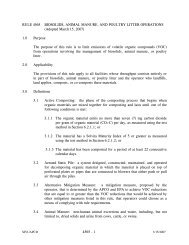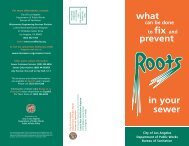City of Los Angeles Integrated Resources Plan (IRP) A New Strategy ...
City of Los Angeles Integrated Resources Plan (IRP) A New Strategy ...
City of Los Angeles Integrated Resources Plan (IRP) A New Strategy ...
- No tags were found...
Create successful ePaper yourself
Turn your PDF publications into a flip-book with our unique Google optimized e-Paper software.
<strong>Integrated</strong> <strong>Resources</strong> <strong>Plan</strong> (<strong>IRP</strong>)A <strong>New</strong> <strong>Strategy</strong> for LA’s Water InfrastructureInformation Sheet<strong>City</strong> <strong>of</strong> <strong>Los</strong> <strong>Angeles</strong>Page No. 1The <strong>Integrated</strong> <strong>Resources</strong> <strong>Plan</strong> (<strong>IRP</strong>) is an inaugural visionary process for stakeholder-basedintegrated water resources planning. The <strong>IRP</strong> incorporates the values <strong>of</strong> <strong>Los</strong> <strong>Angeles</strong>communities into infrastructure planning and integrates planning for the threeinterdependent water systems: wastewater, recycled water and stormwater. By realizing therelationships among these interdependent water resources and planning on a watershedbasis, the community and the environment can get the highest benefit for the least overallcost with the least impact to our communities. Over 100 community leaders have joined the<strong>City</strong> in planning the future <strong>of</strong> wastewater, recycled water and urban run<strong>of</strong>f management in<strong>Los</strong> <strong>Angeles</strong>.<strong>Los</strong> <strong>Angeles</strong> is facing many challenges. These challenges include a growing population, anaging infrastructure for wastewater and stormwater, polluted waters at our beaches andwaterways, a shortage <strong>of</strong> parks and open space, a dependence on imported water and ashortage <strong>of</strong> necessary funding. The <strong>IRP</strong> is the solution for these challenges.After an intensive 4-year process that was built on the stakeholder preferences, 21 initialalternatives were narrowed down to 4 alternatives. These alternatives will meet 20%projected increase in wastewater flow over the next 20 years while maximizing thebeneficial reuse <strong>of</strong> recycled water and urban run<strong>of</strong>f, optimizing the use <strong>of</strong> our existingfacilities and water resources, reducing pollution, and reducing our dependency on importedwater.The <strong>IRP</strong> provides these multi-benefits:Meet future wastewater needsIncreased use <strong>of</strong> recycled waterIncreased local water supplyReduced stormwater pollutionImproved water qualityClean beachesRegulatory complianceImproved water qualityIncreased open spaceEnhanced quality <strong>of</strong> lifeMore jobsThe benefits will be pr<strong>of</strong>ound. The <strong>IRP</strong>includes alternatives that emphasize waterreclamation, which not only helps the waterenvironment <strong>of</strong> California, but also makesperfect sense for the semi-arid region in whichwe live. The <strong>IRP</strong> alternatives reflect thecommunity’s very strong desire to clean upurban run<strong>of</strong>f and stormwater, but also to usethe current wasted resources locally andregionally. Last, but not least, the alternativesdo NOT include a new wastewater or waterreclamation plant, but emphasize maximizinguse <strong>of</strong> the <strong>City</strong>’s existing plants in the SanFernando Valley and at the HyperionTreatment <strong>Plan</strong>t in Playa del Rey.In November 2005, the <strong>City</strong> released draft <strong>IRP</strong> and draft Environmental Impact Report for abroader review by the public. This plan is being developed with the community and for thecommunity and promises to be an example <strong>of</strong> how we can all work together to enhance thequality <strong>of</strong> life in our neighborhoods, improve our water quality, protect the environment.The <strong>IRP</strong> alternatives under consideration include the following elements:• Provide adequate wastewater treatment capacity for increased future, and dryweather run<strong>of</strong>f diversion to treatment plants. Expand the treatment plants by about50 Million Gallons per Day (MGD). Construct three new major sewers to preventsewer overflows.Created on 1/20/2006 12:44 PMH:\ICSD\Projects\SAN Internet\Upload\_SANInternet\irp\documents\012006 <strong>IRP</strong> fact sheet.doc
<strong>Integrated</strong> <strong>Resources</strong> <strong>Plan</strong> (<strong>IRP</strong>)A <strong>New</strong> <strong>Strategy</strong> for LA’s Water InfrastructureInformation Sheet<strong>City</strong> <strong>of</strong> <strong>Los</strong> <strong>Angeles</strong>Page No. 2• Optimize existing plant capacities without siting a new plant.• Implement advance treatment in upstream plants to enhance water quality andincrease beneficial reuse <strong>of</strong> recycled water.• Include diversity <strong>of</strong> plant expansion(s) to show trade<strong>of</strong>fs in cost and flexibility• Increase levels <strong>of</strong> water conservation including a program to individually meterapartments and encourage use <strong>of</strong> cisterns and gray water systems.• Increase recycled water use by providing additional recycling <strong>of</strong> 40,000 to 60,000acre-ft/yr (equivalent to water for 80,000 to 120,000 homes).• Enhance water quality and beneficial use and management <strong>of</strong> dry and wet weatherrun<strong>of</strong>f by managing 26% to 47% <strong>of</strong> dry and wet weather run<strong>of</strong>f (based on run<strong>of</strong>ffrom a ½” Strom). Dry weather run<strong>of</strong>f management potential: 25 MGD (26%) to 41MG (42%). Wet weather run<strong>of</strong>f management potential varies from 660 MGD(39%) to 800 MGD (47%). Run<strong>of</strong>f management includes smart irrigation devices,dry weather run<strong>of</strong>f diversion to sewers, more green space, use <strong>of</strong> porous pavements,treat/beneficial use through a constructed wetlands or urban run<strong>of</strong>f plant, onsitetreatment/discharge or percolation for new or redeveloped areas, schools andgovernment properties, onsite storage and beneficial use, neighborhood and nonurbanrecharge.• Increase water conservation potential by more than 15 MGD• The estimated cost for the <strong>IRP</strong> with full implementation <strong>of</strong> planned elements for the<strong>IRP</strong> alternatives vary from $2.9 Billion to $3.6 Billion. The estimated breakdown is62% for run<strong>of</strong>f management, 15% for recycled water enhancements and 23% forwastewater system upgradesMulti-Benefit Transformation OpportunitiesCreating Green Space, Reducing Polluted Run<strong>of</strong>f and Beneficially Using Run<strong>of</strong>f“Before”“After”“Courtesy <strong>of</strong> Tree People”Created on 1/20/2006 12:44 PMH:\ICSD\Projects\SAN Internet\Upload\_SANInternet\irp\documents\012006 <strong>IRP</strong> fact sheet.doc
















